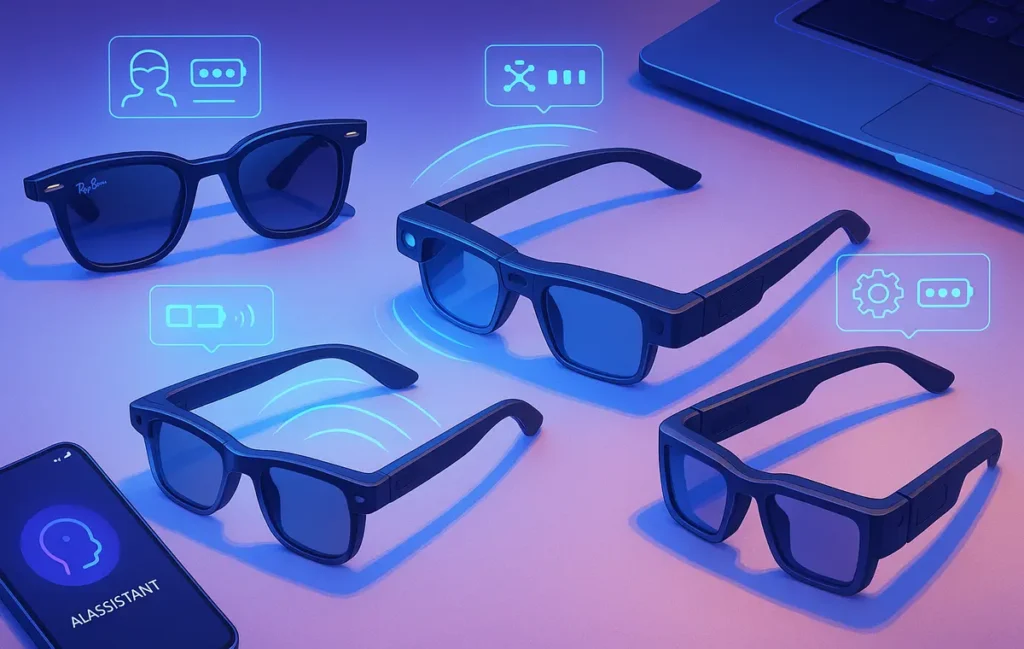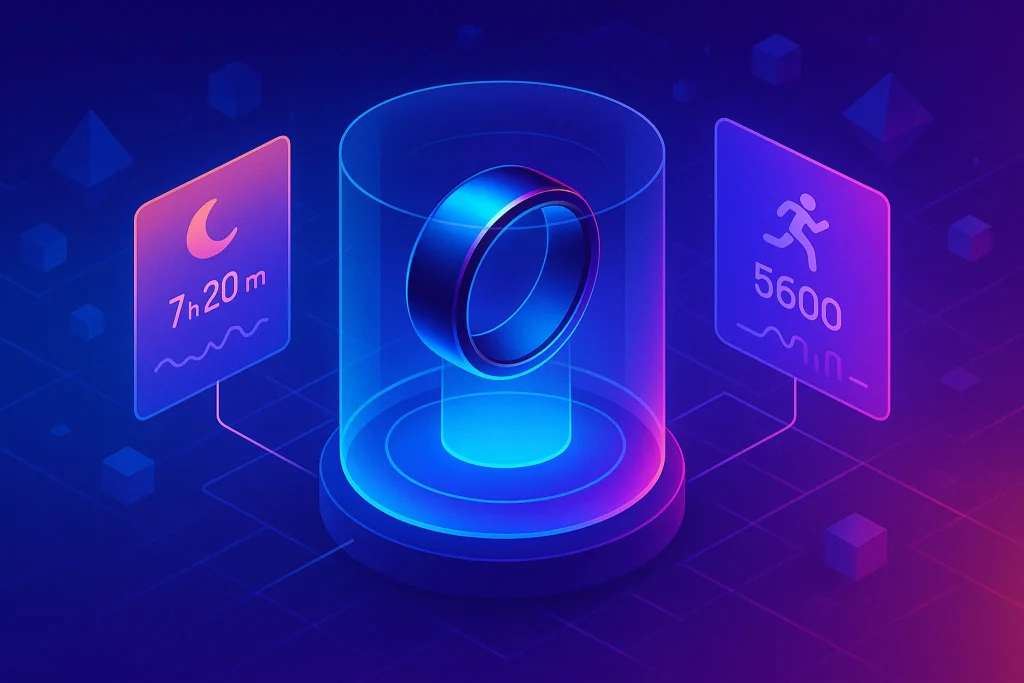👓 Intro
Smart glasses finally crossed the line from “demo” to daily driver. Cameras got quieter, frames got lighter, and the onboard AI stopped feeling like a party trick. In 2025, you can actually choose a pair based on your life—creator, commuter, coder—not just hype. But which models deliver outside the launch keynote?
If you’ve been burned by earlier attempts or you’re still weighing whether the category is real, start by skimming our big-picture take in Smart Glasses: The Next Big Gadget or Just Hype?, then come back for the nitty-gritty. This review is the practical counterpart: how they fit, how long they last, what they see, and whether they earn a place on your face.
💡 Nerd Tip: Buy with your use case, not the spec sheet. The pair that nails “hands-free capture on a bike commute” is rarely the same pair that shines in “second screen for an editor on a plane.”
🧠 What Makes Smart Glasses “Smart,” Really?
At their core, smart glasses add sensors and compute to a frame you’re willing to wear. Some prioritize ambient capture—a discreet camera, beamforming mics, and rapid sharing. Others behave like a personal HUD, projecting crisp virtual screens while your phone does the heavy lifting. The smartest blur both: they pair capture with computer vision so your assistant recognizes what you’re looking at and helps in the moment.
The experience hinges on four pillars. Input determines how you talk to them: wake words, subtle taps, or even gaze. Output ranges from tiny speakers for voice replies to micro-OLED projectors for translucent overlays. Connectivity matters because it decides if your glasses stay useful when your phone is in a backpack. Finally, ecosystem isn’t a buzzword—it decides whether maps, notes, camera rolls, and your favorite work apps sync without duct tape. If you’re deep in Apple land, an iOS-first model will feel “native.” If you live on Windows and Android, a more open ecosystem will age better.
For an opinionated deep dive into where this category is headed (and why the 2025 crop finally “clicked”), see How Wearable Tech and AI Gadgets Are Redefining Our Lives. It explains why ambient AI plus on-device compute changed the vibe from novelty to necessity.
🧪 How We Tested (And What Actually Matters)
We don’t test wearables at a desk. We wore these frames to the office, on commutes, while shooting quick clips for socials, and during weeknight workouts. That’s where comfort, camera behavior, and privacy cues make or break the experience. Battery claims were checked with mixed reality usage: intermittent voice queries, a few photos, some short video bursts, and a couple of HUD sessions (for the display-equipped models). If a pair needed to be nursed to reach dinner, we dinged it.
We paid special attention to social acceptability. Does the LED indicator light clearly when the camera is on? Do people around you notice? Can you disable the shutter sound? Then there’s capture quality: stabilization, low-light noise, and mic pickup in a breezy street or humming café. On the display side, we rated sharpness, perceived brightness in daylight, and eye strain after a Netflix episode or a long spreadsheet.
For shoppers who want the TL;DR across the current market, we maintain a shorter list in Top Smart Glasses You Can Actually Buy Now. This page expands on that with hands-on impressions, trade-offs, and fit notes.
🥇 The Top Smart Glasses of 2025 (Hands-On Reviews)
🕶️ Meta Ray-Ban Display 2 — Best Everyday Companion
Meta’s latest Ray-Ban collaboration keeps the classic look intact but layers in smarter capture and a subtler micro-display that shows glanceable cues without turning your face into a billboard. The draw is effortless moments: tap once, grab a 12MP snap; hold for hands-free video; say a wake word to translate a sign or ask “what building is this?” The AI layer recognizes common objects and text fast enough to feel helpful, then uploads to your phone where editing and sharing are instant.
What surprised us was comfort. The Display 2 stays close to the weight of regular sunnies, so you forget they’re “tech” after an hour. Battery life still isn’t all-day if you shoot a ton of video; think a workday with mixed use and a top-up from the case. Creator-leaning users will love the livestream integration and improved mic array that pulls your voice out of street noise. Privacy gets a real nod: the recording LED is brighter and always-on when the camera is active. Read our focused take on the vision model, camera pipeline, and practical privacy tips in Meta’s Ray-Ban Display Smart Glasses Powered by AI.
Who it’s for: lifestyle creators, commuters, parents who want hands free, anyone who refuses “techy” frames.
Who should pass: people who need a full AR screen; you’re buying ambient AI and capture, not a second monitor.
💡 Nerd Tip: Treat the charging case like AirPods: a short mid-day dock keeps you confident through late-evening plans without battery anxiety.
🖥️ Xreal Air 2 — Best Personal Theater & Second Screen
If you want a cinematic, private display without strapping on a headset, Xreal Air 2 remains the sweet spot. The micro-OLED projection is sharp enough for movies, YouTube, or a vertical triple-app layout when paired with a laptop or gaming handheld. With the right adapter, it talks to consoles too, turning a red-eye flight into a playable session with respectable brightness and clarity. What you don’t get is a camera or an onboard assistant; Air 2 is unapologetically output-first.
We appreciated the lighter nose bridge and better weight distribution over the original Air. After a couple of hours, you still feel the contact points, so swap in the alternate nose pads until you find your fit. For productivity, the magic is a virtual screen that follows you around, no extra monitor required. In cramped spaces or shared homes, that’s more life upgrade than tech toy.
Who it’s for: travelers, students in small spaces, gamers who want immersion without a TV.
Who should pass: vloggers and creators—there’s no camera or AI capture here.
💡 Nerd Tip: Pair with a compact USB-C power bank and a short, right-angle cable—you’ll keep the cable tidy and the display bright without tether fatigue.
🎬 TCL NXTWear S+ — Best Budget “Big-Screen” Glasses
TCL’s NXTWear S+ aims squarely at affordable personal cinema. You plug them in, and you’re looking at a crisp dual-HD “floating” display that’s excellent for Netflix, docs, and retro gaming. They’re not AI-heavy and they won’t replace a laptop screen for color-critical work, but if you want simple, bright, and inexpensive, they’re a great starter pick. The fit is a tad chunkier than Xreal, but not by much, and the magnetic lens cover is convenient for switching between indoors and sunny commutes.
Battery isn’t the issue because they draw power from your device; the limiter is comfort over long sessions. For many, the S+ becomes the “couch companion” and long-flight hero. If you just want immersion and you’re not chasing the newest AR overlays, saving a couple hundred dollars here is defensible.
Who it’s for: movie buffs, casual gamers, anyone curious about display-glasses without the premium tax.
Who should pass: professionals who need color-accurate HDR or creators who want a camera.
🏭 Vuzix Shield — Best Enterprise-Class AR (Niche)
Vuzix keeps shipping practical, rugged AR for warehouses, field service, and manufacturing. Shield is not about fashion; it’s about hands-free workflows—barcodes, checklists, remote expert calls, and safety overlays. You get robust frames, forward-facing cameras with visible capture indicators, and an SDK that assumes you’ll build your own workflows. In that world, all-day battery means hot-swapping packs or neck-pack batteries, and comfort means surviving a 10-hour shift.
If you’re a consumer, move along. If you manage operations at scale, Vuzix Shield earns its keep fast—reducing error rates, shortening training, and keeping eyes up instead of buried in a clipboard. For more consumer-friendly context before you dive into industrial hardware, our primer Smart Glasses: The Next Big Gadget or Just Hype? flags when enterprise AR trickles down to mainstream products (and when it never will).
Who it’s for: operations teams, field techs, safety-critical roles.
Who should pass: literally everyone shopping for lifestyle or creator use.
📝 “Memory” & Life-Logging Glasses (Rewind, Others) — Emerging, Handle With Care
A new niche promises ambient recall: capture audio highlights, screenshots of life, and searchable timelines you can query with voice. When it works, it’s magic—no more “what was that address?” or “who said what?” But it raises real questions about consent and data governance. If you trial one of these, use the strictest visual indicators during capture, set conservative retention windows, and try offline or on-device processing wherever possible.
This category will appeal to power users who love AI note-taking and quantify-everything lifestyles. For most, a combo of a capture-first pair (Meta) plus smart phone workflows is the saner bridge until privacy norms and policies catch up.
Who it’s for: early adopters who live in Notion, Roam, or Obsidian and already run AI summaries on meetings.
Who should pass: anyone who attends sensitive meetings or works under strict compliance.
💡 Nerd Tip: If you even think you should ask for permission before recording, you absolutely should—and wait for explicit “yes.” Build trust before you build datasets.
🎮 Creative, Work, Travel: Which Pair Fits Which Life?
For creators, the equation is dead simple: the best camera is the one that’s already up at eye-level. Meta’s Ray-Ban Display 2 wins because it reduces friction. If you do on-location B-roll or IRL clips, a fast tap beats pulling out a phone. Pair it with cloud workflows and your turnaround time shrinks dramatically. Our capture team has a full setup guide in What New Gadgets Are Worth It? to help you avoid buying extras you don’t need.
For professionals, a display-first pair can be quietly transformative. Xreal Air 2 turns a kitchen table into a dual-monitor workstation. Writers script on a laptop while researching in a floating window; analysts pin dashboards in view without hogging desk space. If your Mac or PC is central to your work and you like the idea of a private, portable monitor, you’ll immediately “get” it.
For travelers and fitness, we lean toward lightweight frames with solid microphones. The better the beamforming, the more usable the assistant on a loud street or subway. If you’re constantly navigating new cities, the “eyes-forward” directions alone can make smart glasses worth it. And for long flights, a display pair doubles as a personal cinema that doesn’t disturb a sleeping neighbor.
To level up your expectations for what’s shipping and what’s still incubating, skim Smart Glasses: The Next Big Gadget or Just Hype? between sections; it keeps your shopping list grounded in reality.
🔌 Ecosystems & Compatibility (The Hidden Deal-Breaker)
Smart glasses are not standalone devices—they’re extensions of your phone, laptop, or cloud. That’s why the “which ecosystem?” question is decisive. If your daily drivers are iPhone + Mac, Apple-friendly integrations (handoff, camera roll sync, iCloud albums, Siri or Shortcuts) make life smooth. On Windows and Android, look for robust USB-C display support, clean Bluetooth handoff, and broad app compatibility. This is also where basic but boring things like permissions and backup matter—you want a product that respects system-level privacy and makes exporting your data painless.
Readers who care about how AI and wearables reshape everyday flows—not in a launch slide, but in actual habits—will love How Wearable Tech and AI Gadgets Are Redefining Our Lives. It maps where “ambient assistants” do real work versus where they still add friction.
💡 Nerd Tip: Test your “day one” workflows before your return window closes: shoot video, share to your go-to platform, trigger a maps route, take a call, and export data. If any of those feel janky, return early.
⚡ Ready to Wear the Future?
See which smart glasses fit your life: creator capture, private screens, or enterprise AR. Compare Meta Ray-Ban, Xreal, TCL and more—then buy with confidence.
💸 Are They Worth It? Value, ROI, and the 90-Day Rule
Two pricing truths. First, you’re paying for comfort and ecosystem polish as much as sensors. Second, the best value is the pair that replaces two or three separate gadgets you already carry. For example, if Ray-Ban Display 2 replaces your phone gimbal for casual shoots and speeds up your capture-to-publish loop, it pays for itself in weeks. If Xreal saves you from buying or lugging an external monitor, same story.
We recommend the 90-day rule: if a pair hasn’t changed your behavior after three months—made you capture more, work faster, or navigate with less friction—sell or return and move on. Don’t let a “future self” fantasy gather dust in a drawer. For help pressure-testing whether this is the right moment to jump in (or to wait), use our decision checklist in What New Gadgets Are Worth It?.
📊 Specs-at-a-Glance (Quick Comparison Table)
| Model | Core Idea | Display | Camera/Mics | Typical Battery | Comfort & Weight | Best For |
|---|---|---|---|---|---|---|
| Meta Ray-Ban Display 2 | Ambient AI + capture in classic frames | Minimal glance display | 12MP camera, beamforming mics | Workday with mixed use + case top-ups | Very wearable; looks like normal sunnies | Creators, commuters, hands-free life |
| Xreal Air 2 | Private big screen | Micro-OLED HUD | None; audio only | Depends on host; draw via USB-C | Light, improved nose bridge | Flyers, students, portable productivity |
| TCL NXTWear S+ | Affordable “cinema” | Dual-HD display | None; audio only | Host-powered via USB-C | Chunkier but fine for sessions | Movies, casual gaming |
| Vuzix Shield | Rugged enterprise AR | Waveguide AR | Industrial cams + strong mics | Shift-length with external packs | Built for PPE environments | Warehouses, field service |
| Memory-first (Rewind, etc.) | Life-logging & recall | Minimal | Audio-first, sometimes photo | Varies; high standby | Light, understated | Power users, quantified-self |
Use this for orientation; the sections above explain the trade-offs in human words.
🔒 Privacy, Safety & Social Cues (Read This Before You Wear)
The smartest feature a pair can ship isn’t a sensor—it’s social affordances. That means bright, unavoidable recording LEDs; obvious shutter sounds in public spaces; and clear ways to disable capture in sensitive areas. If the indicator can be hacked off, avoid it. If you can’t articulate to a friend how your glasses handle their image or voice, you’re not ready to wear them to brunch.
Privacy also lives in defaults. Turn auto-upload off until you’re comfortable with what lands in the cloud. Favor on-device processing wherever available, and limit retention windows for voice and image logs. A tiny habit shift—ask before recording—goes a long way toward keeping wearables welcome in your circle.
💡 Nerd Tip: Create two profiles on day one: “Public Mode” with strict capture limits and loud indicators, and “Solo Mode” for private environments. A Stream Deck or phone shortcut makes switching frictionless.
🧭 Buying Advice: Fit, Lenses, and Long-Term Care
Fit is destiny. A featherweight frame still feels heavy if the nose pads don’t match your bridge or the temples pinch. Spend 10 minutes swapping nose pads, and don’t be shy about heating the temple tips (if the manufacturer allows) for a subtle curve. If you wear prescription lenses, budget for Rx inserts or compatible lens options early; some brands partner with big online opticians to streamline this.
Battery longevity loves conservative settings. Drop display brightness slightly, avoid 4K capture unless you really need it, and let the case top you up between sessions. A microfiber pouch in every bag and a weekly isopropyl wipe keep optics clean and mics crisp. If your work is color-critical, don’t rely on any glasses display as a reference monitor—use a calibrated screen, and bookmark Best OLED Monitors for the real thing.
For creators who plan to treat glasses as a shooting tool—swapping accessories, testing mounts, integrating with mobile editing—our editorial on Top Smart Glasses You Can Actually Buy Now shows a lean kit that travels light.
🚀 Adoption Curve: Where We’re Going Next
From 2025 to 2027, expect three shifts. First, on-device AI will remove round-trip latency for translations and object recognition; pairing with your AI-PC or Neural Engine laptop will push heavier tasks to local silicon. Second, display pairs will get thinner and brighter, making “private big screen” the default for students and frequent flyers. Third, policy and etiquette will harden: clearer signage in venues, standard capture indicators, and region-specific consent rules.
If you want the broader trendline—and how these glasses connect to your laptop, phone, and future home office—our forward-looking piece How Wearable Tech and AI Gadgets Are Redefining Our Lives has the context that helps your purchase age well.
📬 Want More Wearable Reviews Like This?
Join our free newsletter for weekly deep dives on AI wearables, no-code tools, and future-tech workflows—curated and tested by NerdChips. No fluff. Just practical picks that earn a spot in your bag.
🔐 100% privacy. No noise. Just value-packed gadget insights from NerdChips.
🧠 Nerd Verdict
Smart glasses in 2025 finally feel like tools. If you want hands-free moments and glanceable help, the Meta Ray-Ban Display 2 is the most invisible way to add AI to your day. If you want a personal theater or a laptop screen that goes everywhere, Xreal Air 2 earns a slot in your bag. Budget seekers can start with TCL NXTWear S+, and operators who actually turn wrenches should look at Vuzix Shield. The bigger idea: wearables are graduating from gimmick to gear. Buy for your life, not for the launch video—and give yourself 90 days to prove it.
❓ FAQ: Nerds Ask, We Answer
💬 Would You Bite?
If you had to pick today, would you go Ray-Ban Display 2 for everyday capture or Xreal Air 2 for a portable private screen—and why?
Crafted by NerdChips for creators and teams who want their best ideas to travel the world.



